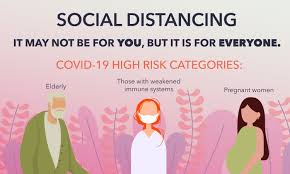COVID-19 has shaken the world, and no one knows what to expect next. Has the virus peaked, or will it get worse? When thinking about writing this post, I was at a loss on where to begin. There is so much information out there and so little time to figure it out. I realized the most helpful article would be one that pointed me to more information. Therefore this post is all encompassing and will briefly go over facts about the coronavirus, social distancing, and anxiety with links to unbiased sources.
1. Know What You Are Up Against
#knowledge
When facing a pandemic, it can feel like we are against an invisible enemy or even a ghost. However, this isn’t the case. Let’s take a closer look at this virus called SARS-CoV-2 that causes the disease COVID-19. The SARS-CoV-2 virus is part of a family of coronaviruses, named based on their crown-like appearance (corona means “crown” in Spanish). Coronaviruses originally infected bats and transformed to infect other animals and eventually humans through a process called zoonosis. Coronaviruses cause up to ⅓ of common cold cases. Previous coronavirus strains have caused outbreaks such as the Middle Eastern Respiratory Virus (MERS) in 2012 and the Severe Acute Respiratory Syndrome (SARS) in 2003. SARS-CoV-2 is actually very similar to the SARS virus, which has reduced time necessary for drug discovery and vaccine development. Thankfully, SARS-CoV-2 is not as deadly as these previous coronavirus outbreaks; however, it is much more contagious.
It is known how the virus infects and makes you sick. Briefly, the virus infects lung cells in the alveoli (the tiny air sacs in your lungs) causing them to create more viruses (watch this video for a more in-depth look at the disease). The immune system increases the body’s temperature in attempt to kill the disease, leading to a fever. To aid with defense against the virus, the immune system increases fluid to the alveoli to allow more immune cells to access the infected alveoli. This response causes a mucus build-up in the lungs which causes patients to cough. Increasing the liquid in the alveoli decreases the concentration of surfactant, leading to alveoli collapse and respiratory difficulty. In summary, the common symptoms for COVID-19 are coughing, fever, and difficulty breathing. Digestive issues appear to be an early symptom of infection; however, this is not confirmed. Though infection is not always serious, if enough respiratory difficulty ensues or if the virus infects a vulnerable person, like an elderly or immunocompromised patient, it can be severe. This knowledge is important as the virus continues to spread like wildfire, as can be seen in John Hopkins coronavirus map. So, what can we do? The answers, described below, are social distancing and sanitation.

2. Know You Can Save Lives
#socialdistance #sanitation #beahero
COVID-19 is extraordinarily contagious with a very concerning death rate. For comparison, the common flu typically has a death rate of 0.1% and on average is spread to 1 person. COVID-19, on the other hand, has an estimated death rate of 1% and on average one patient spreads it to 2-3 people. Commonly, viruses spread through coughing and sneezing respiratory droplets, oral-fecal route, or poor hand washing by infected individuals who then touch surfaces. COVID-19 is no different. What is unique to COVID-19 is its long retention on surfaces (up to 72 hours) and in the air (up to 3 hours). Though only 0.1% of COVID-19 viruses can last up to these lengths, it is uncommon for a virus to even survive that long. Another key feature to the virus’s spread is the long pre-symptomatic incubation period, which allows people to pass it on before being diagnosed. We must slow down the spread of this virus, which is why social distancing and sanitation practices are essential. Because of the high contagion of this virus, we must fully implement these practices to save thousands of lives. COVID-19 has the potential to spread rapidly and overwhelm our healthcare system. We must flatten the curve to allow for more people to survive.
You can also help save lives by not buying any item in excess, especially personal protective equipment (PPE), which you should not buy unless you are already sick. PPE needs to be saved for health care professionals who are in constant contact with the virus. Several nurses and health care providers have already gotten sick due to limited PPE. Not buying other items in excess can greatly reduce panic. In these times of turmoil, we need to be conscious of other people and realize that we are all struggling. We should not be stressing each other out by buying a year’s worth of supplies and causing shortages. A two week supply is plenty. At these times, we need to come together, focus on each other, and realize how listening to others and the CDC guidelines can help you be a hero and save lives.
3. Know How to Keep Your Sanity
#loveall #loveyourself
So, you have stocked up on two weeks worth of supplies and are ready for isolation. Initially, it is pretty fantastic, with unlimited Netflix and video games! But by day two or three, you realize something is missing. You feel bored, anxious, and like something is wrong, with so much uncertainty in the world. What do you do now?
- You are going to feel uneasy until you accept how you are feeling. This might sound like common sense, but as described in Amala John’s Pipettepen post, “Is it just fear talking?”, it is the first and hardest step. Some people will not realize they are afraid until it bubbles to the surface. Although these are frightening and challenging times, remember that it is okay to be afraid and to recognize that fear.
- Next, you need to accept that you do not have any control. The virus will spread, and there is nothing you alone can do about it. However, as a society we can come together and continue to slow it down. As my mom reminded me, it is absurd to blame yourself if you get sick. You have to remember to be kind to yourself.
- We must support each other. Though we feel isolated, we must not forget how much access we have to each other. Call the ones you love. Little three word sentences, like “I love you” or “I miss you”, can mean the world to people in this tough time.
- Find productive and non-electronic activities. Meditation can be amazing at easing the mind. Going for a walk outside can do wonders. Even simply opening your blinds so that natural light comes in can feel freeing. Many of us are without work, so finding productive hobbies such as drawing, painting, or learning something new, can create a sense of purpose.
- AVOID SOCIAL MEDIA and NEWS MEDIA. I intentionally hyperlinked non-biased sources in this entire article. The media will consume you and cause you to panic.
For additional advice go to: https://www.mentalhealthfirstaid.org/
4. Know There is a Future and a Day Past This
#Wearesurvivors
Together, we will get through this. We have survived even worse pandemics as a nation, like the Spanish flu, and we will survive this. No one can tell you when this will be over, but modern medicine is phenomenal. There are some possible antiviral drugs, such as chloroquine which blocks the viruses from entering the cell, that have been shown to reduce COVID-19 infection (in depth description of treatments). Summer heat will hopefully weaken the virus due to reduced spreadability and weakened viral membranes in heat. This will give us more time to research the virus and develop a vaccine, which several companies already have underway. We do need to be realistic. It will get worse before it gets better. Though we are diligently working on treatments and a vaccine, we do not yet have either. However, we will survive this and become stronger because of it. Hopefully by understanding the virus and how/why we are responding the way we are, we can begin to make some light of this currently dim world.

For even more information here are FAQ on the coronavirus
Peer edited by: Isabel Newsome & Yogitha Chareddy
